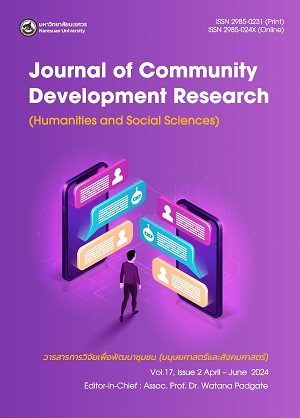Analyze the Gamification Application User Target Group and Formulate Design Strategies for Cultural Tourism: Case Study of Huizhou
##plugins.themes.bootstrap3.article.main##
Abstract
In the era of digital tourism, integrating gamified interactive entertainment with traditional tourism has enhanced the cultural tourism experience. This study explores tourists’ diverse needs for cultural tourism gamification in Huizhou through precise user research, aiming to attract and maintain user participation and provide a scientific basis for developing such applications. The research objectives are to understand users’ needs and expectations for Huizhou’s cultural tourism gamified applications and to clarify target user groups for formulating targeted gamification strategies. Based on user-centered design principles, researchers interviewed and observed tourists in tourist attractions (N = 30) and distributed and collected valid questionnaires (N = 514). The study used the MDA framework to conduct qualitative and quantitative analyses of tourists’ concerns, experiences, functional needs, and artistic style preferences. Results indicate that target users are mainly digital native self-guided tourists, with 81.12% showing high interest in gamified cultural tourism applications, compared to 28.69% of non-digital natives. Tourists expect apps to provide useful information features to enhance their travel experience, particularly by providing detailed and informative explanations of attractions. Additionally, they are concerned with the application’s ease of use and privacy protection. Aesthetically, Chinese line-drawing cartoon styles and travel visual experiences are favored. The proposed gamification strategy balances education, entertainment, and practicality to improve user engagement and experience. These findings offer crucial insights for developers and provide precise guidance for market positioning and product design strategies.
Keywords: Cultural Tourism, Gamification Application, Design Strategies, User-Centered Design, MDA Gamification Design
References
Coghlan, A., & Carter, L. (2020). Serious Games as Interpretive Tools in Complex Natural Tourist Attractions. Journal of Hospitality and Tourism Management, 42, 258-265. https://doi.org/10.1016/j.jhtm.2020.01.010
Deterding, S. (2012). Gamification: Designing for Motivation. Interactions, 19(4), 14-17. https://doi.org/ 10.1145/2212877.2212883
Eisingerich, A. B., Marchand, A., Fritze, M. P., & Dong, L. (2019). Hook vs. Hope: How to Enhance Customer Engagement Through Gamification. International Journal of Research in Marketing, 36(2), 200-215.
Kawulich, B. B. (2005). Participant Observation as a Data Collection Method. Forum Qualitative Sozialforschung/Forum: Qualitative Social Research, 6(2), 43. https://doi.org/10.17169/fqs-6.2.466
Khan, I., Melro, A., Amaro, A. C., & Oliveira, L. (2020). Systematic Review on Gamification and Cultural Heritage Dissemination. Journal of Digital Media & Interaction, 3(8), 19-41. https://doi.org/10.34624/jdmi.v3i8.21934
Kim, B. (2015). Game Mechanics, Dynamics, and Aesthetics. Library Technology Reports, 51(2), 17-19.
Leclercq, T., Hammedi, W., & Poncin, I. (2018). The Boundaries of Gamification for Engaging Customers: Effects of Losing a Contest in Online Co-creation Communities. Journal of Interactive Marketing, 44(1), 82-101. https://doi.org/10.1016/j.intmar.2018.04.004
Lu, Y., Yuan, F., Lin, J., & Yuan, K. (2020). TouristGo: A Location-based Mobile Game to Improve Tourist Experience by Visiting Path Optimisation. Personal and Ubiquitous Computing, 24(3), 405-418. https://doi.org/10.1007/s00779-019-01327-9
Luimula, M., & Trygg, N. B. (2016). Cultural Heritage in a Pocket: Case Study “Turku Castle in your Hand”. In 7th IEEE International Conference on Cognitive Infocommunications (CogInfoCom 2016), Wrocław, Poland, October 16-18, 2019. https://doi.org/10.1109/CogInfoCom.2016.7804524
Malterud, K., Siersma, V. D., & Guassora, A. D. (2016). Sample Size in Qualitative Interview Studies: Guided by Information Power. Qualitative Health Research, 26(13), 1753-1760. https://doi.org/10.1177/ 1049732315617444
Pasca, M. G., Renzi, M. F., Mugion, R. G., Toni, M., & Di Pietro, L. (2020). Gamification in Tourism Context: a Systematic Literature Review. In J. Koivisto, M. Bujić, & J. Hamari (Eds.), GamiFIN Conference 2020, Proceedings of the 4th International GamiFIN Conference, Levi, Finland, April 1-3, 2020 (pp. 103-114). Finland: Tampere University. Retrieved from https://ceur-ws.org/Vol-2637/
Pendit, U. C., Zaibon, S. B., & Abubakar, J. A. (2015). Digital Interpretive Media Usage in Cultural Heritage Sites at Yogyakarta. Jurnal Teknologi, 75(4), 71-77.
Poux, F., Valembois, Q., Mattes, C., Kobbelt, L., & Billen, R. (2020). Initial User-centered Design of a Virtual Reality Heritage System: Applications for Digital Tourism. Remote Sensing, 12(16), 2583. https://doi.org/10.3390/rs12162583
Skinner, H., Sarpong, D., & White, G. R. T. (2018). Meeting the Needs of the Millennials and Generation Z: Gamification in Tourism Through Geocaching. Journal of Tourism Futures, 4(1), 93-104. https://doi.org/10.1108/JTF-12-2017-0060
van Nuenen, T., & Scarles, C. (2021). Advancements in Technology and Digital Media in Tourism. Tourist Studies, 21(1), 119-132. https://doi.org/10.1177/1468797621990410
Venkatesh, V., Brown, S. A., & Bala, H. (2013). Bridging the Qualitative-Quantitative Divide: Guidelines for Conducting Mixed Methods Research in Information Systems. MIS Quarterly, 37(1), 21-54. Retrieved from https://www.jstor.org/stable/43825936
Wee, S.-C., & Choong, W.-W. (2019). Gamification: Predicting the Effectiveness of Variety Game Design Elements to Intrinsically Motivate Users’ Energy Conservation Behaviour. Journal of Environmental Management, 233, 97-106. https://doi.org/10.1016/j.jenvman.2018.11.127
Williams, M., Yao, K. K. K., & Nurse, J. R. C. (2017). ToARist: An Augmented Reality Tourism App Created Through User-centred Design. In Proceedings of the 31st International BCS Human Computer Interaction Conference (HCI 2017), Digital Make-Believe, with Delegates Considering Our Expansive, Sunderland, UK, July 3-6, 2017. UK: BCS Learning and Development. https://doi.org/10.14236/ewic/HCI2017.1
Xi, N., & Hamari, J. (2019). Does Gamification Satisfy Needs? A Study on the Relationship between Gamification Features and Intrinsic Need Satisfaction. International Journal of Information Management, 46, 210-221. https://doi.org/10.1016/j.ijinfomgt.2018.12.002
Xi, N., & Hamari, J. (2020). Does Gamification Affect Brand Engagement and Equity? A Study in Online Brand Communities. Journal of Business Research, 109, 449-460. https://doi.org/10.1016/j.jbusres.2019.11.058
Xu, F., Tian, F., Buhalis, D., Weber-Sabil, J., & Zhang, H. (2016). Tourists as Mobile Gamers: Gamification for Tourism Marketing. Journal of Travel & Tourism Marketing, 33(8), 1124-1142. https://doi.org/10.1080/10548408.2015.1093999
Xu, F., Weber, J., & Buhalis, D. (2013). Gamification in Tourism. In Z. Xiang, & I. Tussyadiah (Eds.), Information and Communication Technologies in Tourism 2014, Proceedings of the International Conference in Dublin, Ireland, January 21-24, 2014 (pp. 525-537). Cham: Springer. https://doi.org/10.1007/978-3-319-03973-2_38
